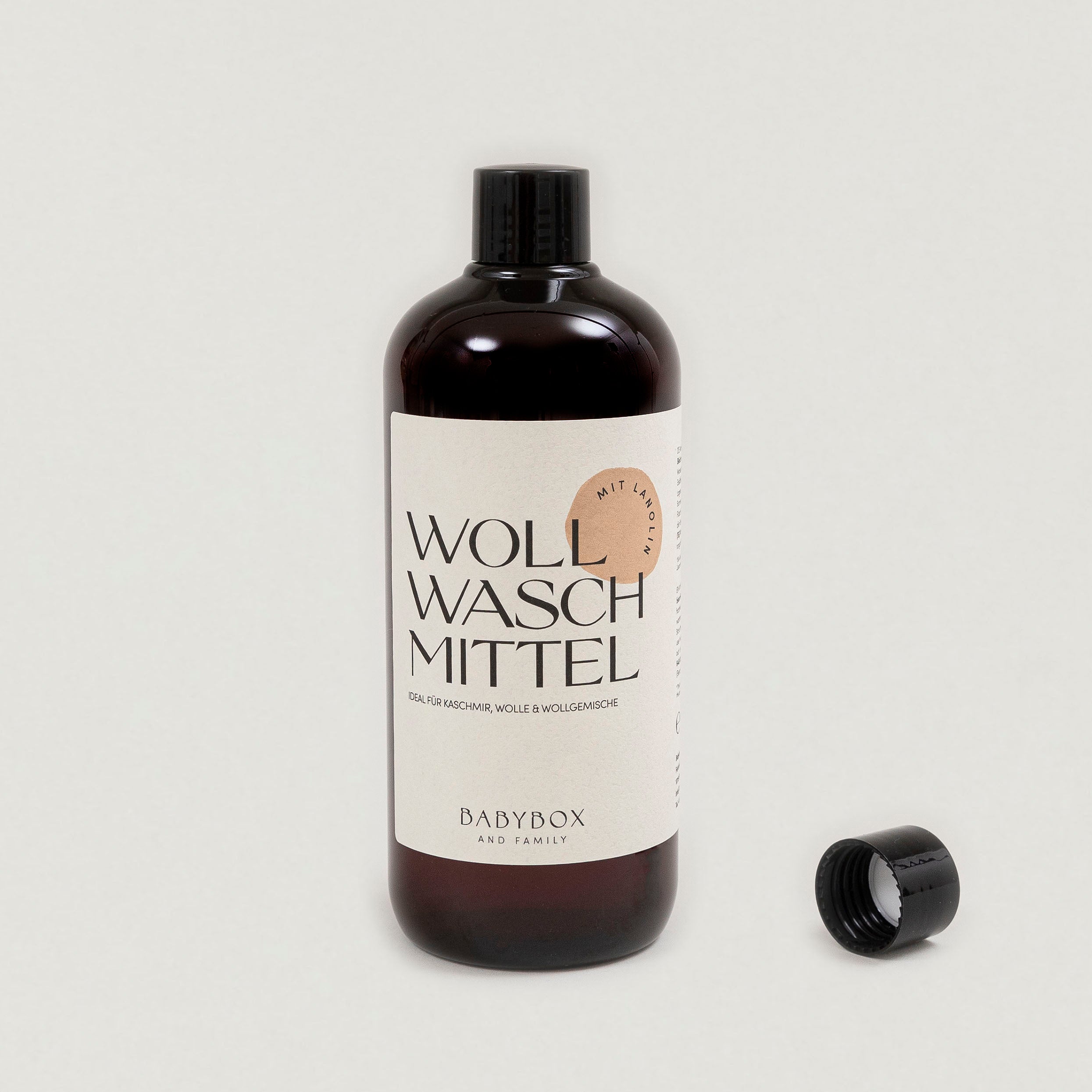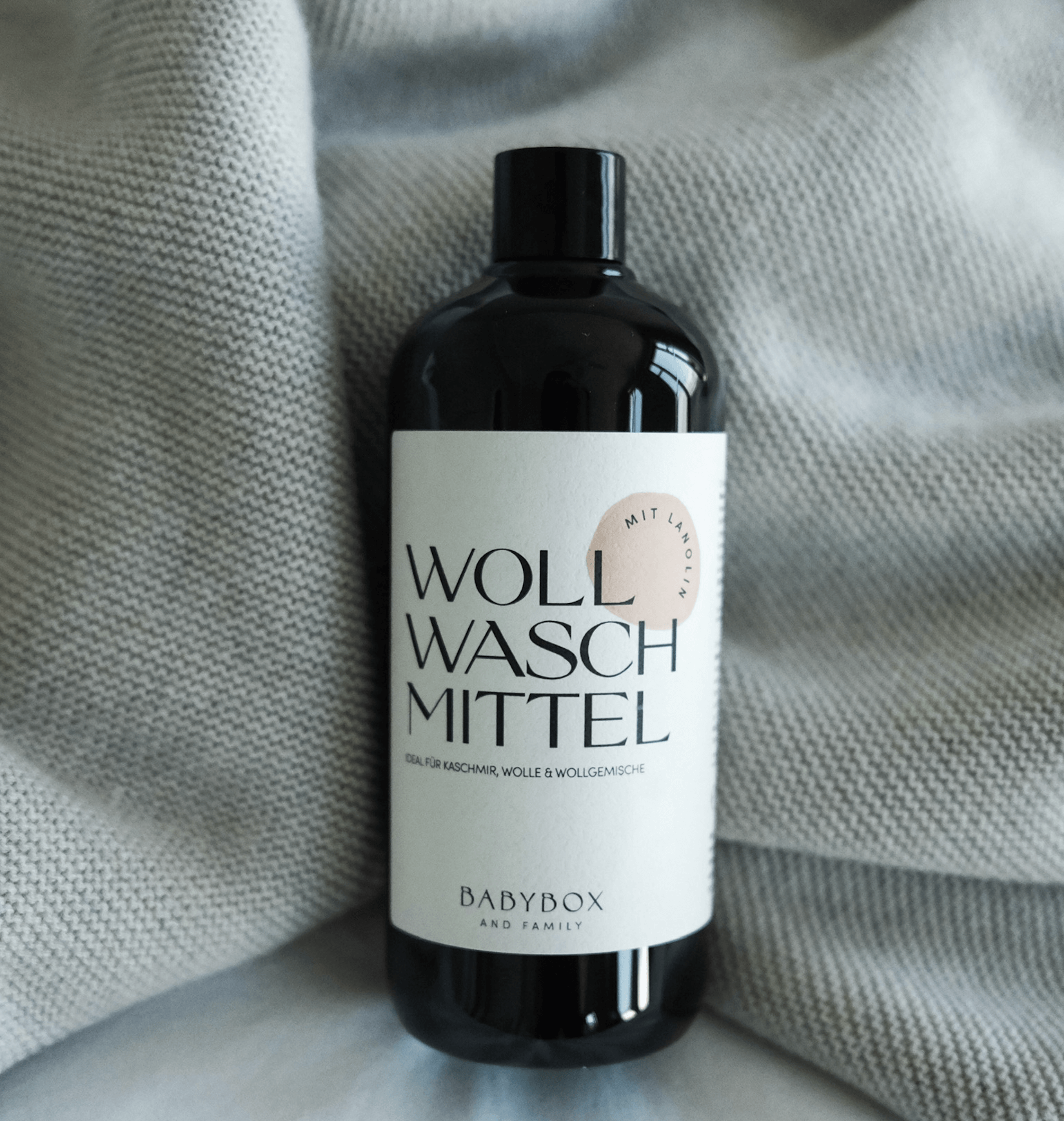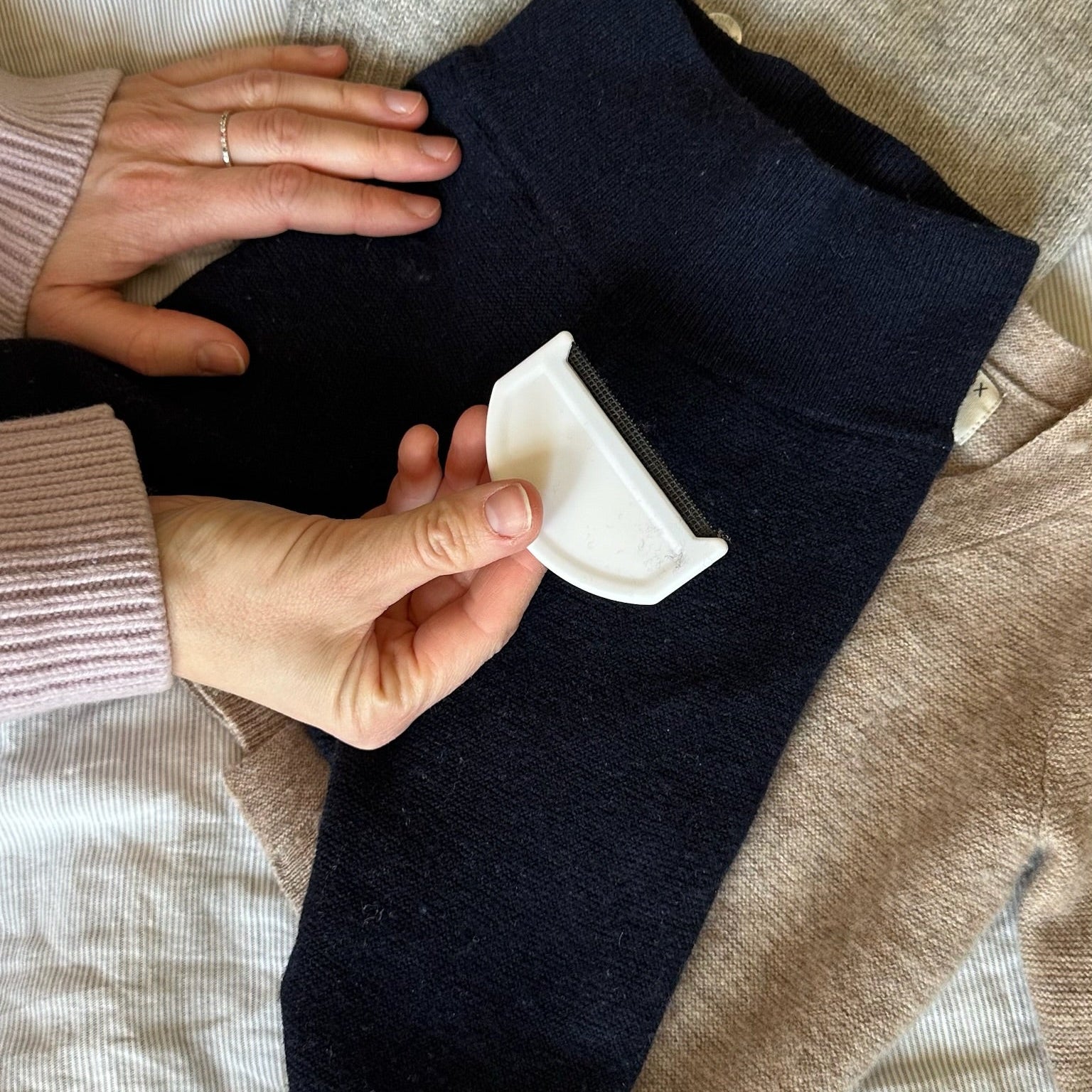Key Points at a Glance:
Wool is a natural fiber made of keratin, known for being warm, breathable, elastic, and dirt-repellent. These properties make it especially suitable for delicate baby and children's skin. To protect the wool fibers, it's important to take care when washing. Use cold to lukewarm water and a mild wool detergent. Wash wool gently by hand or on a wool cycle, press it out gently (do not wring), and let it dry flat on a towel. Due to its natural properties, wool does not need frequent washing.
Wool is a natural material with incredible properties that make it an essential part of any child's wardrobe. However, caring for wool, especially baby and toddler clothing, can sometimes be confusing. To help, we’ve gathered everything you need to know about wool and how to care for it.
What is Wool... and What Makes Wool Special?
Wool fibers, like our hair and nails, are made of keratin—a versatile and functional natural protein. Here’s why wool stands out:
- Natural Elasticity and Shape Retention
Wool fibers are naturally elastic, stretching and returning to their original shape without compromising their structure. This elasticity gives wool garments long-lasting durability and shape retention—perfect for baby and children’s clothing. - Excellent Insulation Properties
Wool provides outstanding thermal insulation with microscopic air chambers that trap body heat while wicking away excess warmth. This makes wool suitable for both cold and warm conditions, as it balances temperature effectively. - Moisture Regulation
Wool can absorb up to 30% of its weight in moisture without feeling damp. This ability to absorb and release moisture helps keep wool clothing comfortably dry, even in fluctuating weather. - Breathability
The structure of wool allows air to circulate, keeping the skin breathable and preventing excessive sweating. This makes wool exceptionally comfortable to wear. - Dirt and Odor Resistance
Naturally resistant to dirt and odors, wool’s fiber structure and lanolin oil make it difficult for contaminants to penetrate. Often, airing out wool clothing is enough to neutralize odors. - Natural Flame Retardancy
Wool has a high self-ignition temperature and chars rather than melts when exposed to flames, making it safer than many synthetic fibers.
How to Wash Wool the Right Way:
Caring for wool is straightforward once you understand its needs. Follow these essential tips:
- Follow Care Instructions
Always read the care labels provided by the manufacturer. Each garment may require specific care based on its material composition. - Wash Wool in Cold Water
Wool does better with cold water (below 30°C) and gentle washing. Use your washing machine's wool cycle or wash by hand. Tip: Use a laundry bag to minimize friction and reduce the risk of felting. - Use a Low Spin Speed
Avoid high spin speeds, which can damage wool fibers. Excessive agitation can cause matting and shrinkage. - Dry Wool Properly
Lay wool garments flat to dry in the fresh air. If washing by hand, lay the item on a towel, gently press out excess moisture, and let it dry flat. - Avoid Direct Sunlight and Heat
The high temperatures that come from heaters or direct sunlight can damage wool fibers and cause colors to fade. Dry wool away from direct heat sources and sunlight.
Why the Right Wool Detergent Matters
Conventional detergents made with enzymes and harsh chemicals can damage wool fibers and are often not environmentally friendly. Choose an organic wool detergent to protect those fibers. We recommend using a wool detergent with lanolin, which replenishes the wool's natural oils with each wash. To ensure your woolen clothes last and remain easy to care for, we sell our very own Babybox Wool Laundry Detergent, made with lanolin.

How to Wash Wool Properly
Taking care of wool isn’t very demanding if you understand its basic needs. Here are five essential points to keep in mind when washing wool:
1. Before Washing - Follow the Manufacturer's Instructions
Our recommendation: Always read the care instructions provided by the manufacturer for each garment. The specific composition and origin of the materials often require individual care.
2. Wash Wool Cold
Wool does not like high temperatures and is sensitive to strong mechanical effects, such as high spin speeds. It's best to wash wool, like Merino wool, lambswool, or wool blends (e.g., wool & silk), cold, at under 30°C, either in the wool cycle of the washing machine or by hand. Tip: Use a laundry bag in the washing machine to prevent friction with the drum and reduce the risk of felting.
3. Low Spin Speed During the Wool Cycle
Ensure that the spin speed is not too high during the wool cycle. Excessive mechanical action can alter the protein structure of the wool fibers, causing irreversible damage such as felting or shrinking of the garment.
4. Drying Wool Clothing
It’s best to let wool clothing dry flat and in fresh air. If washing by hand, it’s recommended to place the wet clothing on a dry towel, gently roll it up to remove most of the moisture, and then let it dry flat.
5. Avoid Direct Sunlight and Heat from Heaters When Drying
High temperatures, such as those from direct heat on a heater, can cause wool fibers to dry out. The natural wool fat (lanolin) that keeps the fibers supple can evaporate, making the wool brittle and fragile. Direct sunlight can also cause colors to fade, as UV rays are particularly harmful to dyes.
Why the Right Wool Detergent Is Crucial
Conventional detergents often contain enzymes and harsh chemicals that can damage wool’s protein fibers and are not fully biodegradable, making them not environmentally friendly. Use a good organic wool detergent to properly care for and protect the fibers. We recommend a wool detergent with lanolin, which replenishes the wool fat during each wash, so you don’t have to worry about when and how much lanolin to add.
To ensure that you can enjoy your wool clothing for a long time and that it’s easy to care for, we have developed our own Babybox wool detergent with lanolin. It helps you maintain your laundry’s quality and keep it simple to care for.
Wool Laundry Detergent with Lanolin
With our Wool Laundry Detergent with Lanolin from the Babybox and Family Collection, we’ve considered everything to ensure optimal care for your wool garments:
- Dermatest Certified "Very Good"
Perfect for sensitive baby skin, our detergent has been rigorously tested and approved for its gentle touch. - Free from Harmful Additives
Contains no palm oil, enzymes, petrochemicals, bleaches, or dyes. - Microplastic-Free
Our formula is completely free of microplastics. - Cruelty-Free
We do not test our product on animals. - Sustainable and Eco-Friendly
Made from biodegradable and sustainable raw materials, and produced in Germany with environmental care. - Award-Winning Sustainability
Our detergent holds the NCP Nature Care Product award and is regularly tested by ECO Control, reflecting our commitment to sustainability and environmental protection.
Every wash ensures your wool clothing receives the best care while being kind to the planet. Experience the difference for yourself!
FAQ
Wool fibers, primarily composed of keratin, are sensitive to high temperatures. Excessive heat destabilizes the protein structure, causing the wool to shrink. High temperatures also release the natural wool fat, making the fibers brittle and similar to split ends in hair. This results in wool becoming stiff and scratchy. Additionally, heat and aggressive movement can disrupt the wool's scale structure, causing the fibers to open up. When water seeps in, the fiber swells and mats due to friction. In contrast, cold water preserves the stability of the fiber structure, helping the garment maintain its size and shape.
When washing wool in a washing machine, it’s crucial to minimize mechanical stress and use gentle settings. By controlling both the agitation and water temperature, we prevent shrinkage, fiber damage, and matting, keeping your wool garments in great shape.
A special wool detergent is essential because wool has unique properties that differ from other fabrics. Here’s why using a wool-specific detergent is so important:
- Sensitive Fibers
- Wool: Made of delicate protein fibers (keratin), wool is more fragile compared to cotton or polyester. Standard detergents often contain enzymes and harsh chemicals that can damage wool’s protein structure.
Wool Detergents: These are specially designed to protect wool’s delicate fibers and maintain its natural structure.
2. pH Balance
- Standard Detergents: typically have a higher pH, suitable for cotton and synthetics, but can harm wool. A high pH can strip wool of its natural cuticle, causing matting and shrinkage.
- Wool Detergents: Have a neutral or slightly acidic pH that protects wool and reduces the risk of matting.
3. Enzymes
- Standard Detergents: Often include enzymes like proteases to break down stains. However, these enzymes can also damage wool’s protein structure and weaken the fibers.
- Wool Detergents: Usually enzyme-free or contain special enzymes that are safe for wool.
4. Softness and Care
- Wool Detergents: Often include conditioning agents like lanolin, a natural fat found in sheep’s wool that keeps the fibers soft and maintains their natural water-repellent properties.
5 Avoiding Matting
- Standard Detergents: Can cause wool fibers to tangle and mat, especially at higher temperatures and with vigorous washing.
- Wool Detergents: Designed to minimize matting and keep the fibers soft and flexible.
6. Temperature and Washing Cycles
- Wool Detergents: Formulated for gentle washing cycles recommended for wool, such as cold water and slow drum movements.
In summary, wool detergents are designed to protect and preserve the delicate wool fibers, extending the life of your wool clothing. Using a standard detergent can lead to damage, matting, and a shorter lifespan for your wool products.
With every wash, wool loses its natural lanolin, the essential oil that keeps it soft and supple. This loss also affects wool’s natural properties, such as its dirt and odor resistance, and its ability to regulate temperature. To keep your wool garments durable and comfortable, it's crucial to replenish this natural oil.
Our wool laundry detergent with lanolin does just that. By adding lanolin back into the wool, it helps maintain the fabric’s softness and restores its natural benefits—like being dirt-repellent and odor-resistant. With each wash, you’re ensuring your wool clothing stays in top shape and continues to perform beautifully.
Wool and wool & silk clothing that has little to no wool fat feels hard and brittle. Unfortunately, it is almost impossible to completely re-grease wool that has been washed out. Therefore, you should regularly use lanolin with every wash right from the start to prevent this from happening.
If your wool clothing has become matted due to washing it at too high a temperature, there are a few steps you can try to reduce the damage, though it's important to note that fully restoring matted wool is often not possible. Here’s what you can do:
1. Moisturizing and Conditioning Treatment
- Materials: Hair conditioner or baby shampoo, lukewarm water
- Directions:
- Fill a sink or bowl with lukewarm water.
- Add a generous amount of conditioner or baby shampoo, stirring until dissolved.
- Soak the matted garment in this mixture for about 30 minutes. The conditioner helps relax and soften the wool fibers.
- After soaking, gently squeeze out the water (avoid wringing).
- Lay the garment flat on a towel, gently reshape it, and allow it to air dry flat. You can gently adjust the shape as it dries.
2. Professional Help
- If the matting is severe and home remedies don't work, consider seeking professional assistance. Some dry cleaners or textile repair services specialize in treating damaged wool.
2. Creative Reuse
- If the wool cannot be fully restored, you might find creative ways to repurpose it. For example, matted wool can be used for craft projects like making felt coasters or other items.
Note: While these methods may help improve the appearance of matted wool, there’s no guarantee of complete restoration. To prevent future damage, always wash wool garments according to their care instructions.
Pilling is something we commonly encounter with woolen clothing, when small, unsightly balls form on the surface. These are caused by friction that loosens fibers from the fabric, causing them to mat. While some pilling is inevitable in everyday wear, you can take steps to minimize it:
- Gentle Care
Always wash wool gently, either by hand or using the wool cycle on your washing machine. Turn garments inside out and use a mild wool detergent that’s kind to the fibers. - Minimize Friction
Avoid excessive rubbing by keeping wool clothing away from rough surfaces. For example, try not to carry backpacks or bags directly against the wool fabric. - Proper Storage
Store woolen clothes loosely, either by hanging them or laying them flat. Avoid compressing them, as this can cause friction and lead to pilling. - Choose Quality Wool
High-quality wool is less prone to pilling. Investing in well-made wool garments can pay off, as they are often better processed and more resistant to pilling.
By following these tips, you can reduce pilling and extend the life of your wool clothing, keeping it looking great for longer.
Treating Pilling:
- Use a Pilling Remover
Use a pilling remover or lint shaver to carefully cut away the pills. Handle the tool gently to avoid damaging the wool fibers. - Lint or Wool Comb
A specialized wool comb can effectively remove pilling. Gently comb over the affected area to loosen and lift the pills. - Disposable Razor
A disposable razor can also be used to remove pilling. Use it very gently to prevent any damage to the fabric.
Quick Tip: Lay the garment on a flat, hard surface and pull it taut before removing the pilling. This technique helps protect the fabric while you work.
Wool naturally repels dirt due to its surface structure and lanolin, which makes it less prone to absorbing stains. However, if stains do occur, it’s important to act quickly before they set. Here’s how to handle it:
- Blot the Stain
If the stain is still wet, gently blot it with a clean cloth to absorb as much liquid as possible. Avoid rubbing, as this can spread the stain. - Rinse with Cold Water
Rinse the stained area with cold water. Hot or warm water can set the stain further into the fibers, making it harder to remove. - Treat with Gall Soap
If the stain remains, use gall soap, which is highly effective for removing stains from wool. Rub the soap into the stain, let it sit for a few minutes, and then wash the garment according to the care instructions—either by hand or on the wool cycle of your washing machine.
For felted wool items, like wool felt overalls or jackets, which have been exposed to dirt and have undergone a manufacturing process that changes the wool fibers:
- Allow surface dirt, such as sand or grime, to dry. Once dry, gently brush it off with a suitable brush.
Our Insider Tip: Try the Miracle Brush from Leistner for effective cleaning.
Tip
What's the right way to get rid of pilling?
Washing Wool
Key Wash Symbols at a Glance
Washing symbols can be confusing, especially since they’re often just icons without explanations. To help you understand how to care for your wool garments, we’ve gathered the most important washing symbols and their meanings according to GINETEX. Here’s a quick guide to the symbols you need to know for washing wool:
Washing by Hand
Use water no hotter than 40°C, depending on the item. First, dissolve your mild detergent or wool detergent in plenty of water. Gently place the textiles into the solution, allowing them to float. Avoid rubbing, pulling, or wringing the fabric. After washing, rinse the items thoroughly, gently squeeze out excess water, and reshape them while damp. For colored and delicate fabrics, handle them promptly and avoid letting them sit wet.
Special gentle wash cycle
30 °C delicates/woolens. Items made of machine-washable wool, for example. This wash cycle involves a particularly gentle mechanical treatment. Reduce the amount of laundry considerably (only fill the drum up to a third). Set the appropriate wash program.
Gentle hand wash
Gentle hand wash. Maximum temperature: ambient temperature. First dissolve the detergent for delicates/wool in plenty of water. Place the textiles in the solution so that they float and move carefully. Do not rub, do not pull or wring. Then rinse the textiles well, squeeze carefully and pull into shape. Treat colored and delicate items of laundry quickly and do not leave them lying around wet.
Do not tumble dry
Do not tumble dry. Item does not tolerate tumble drying.
Iron at a moderate temperature
Iron at a maximum temperature of 160°C, which matches the "wool/silk/polyester/viscose" setting on most irons. Iron while the fabric is still slightly damp, using a cloth to protect it. You can use steam, but avoid pressing too hard or stretching the fabric.
Lay Flat to Dry
e.g. long wool jackets so that they do not lose their shape.












